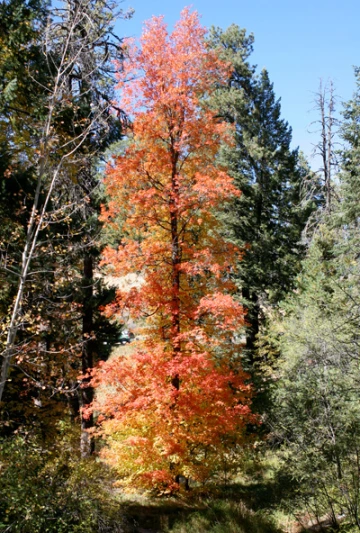Botanical Family: Sapindaceae
Scientific Name: Acer grandidentatum
Common Names: bigtooth maple
Botanical Description:
Acer grandidentatum is a deciduous tree, or a large, multi-stemmed shrub, growing to 10 to 15 meters in height at maturity, with a round, spreading crown (1,2,3). The thin bark is dark brown in color, scaly, and shallowly furrowed, with grayish flat-topped ridges (2,3). Young branches are lightly pubescent, and green to red in color, becoming chestnut brown to gray, and glabrous with age (1,2,3). The specific epithet, grandidentatum, meaning “large-toothed”, is a reference to the leaves of this species (3). The broad leaves, appearing opposite one another along the stems, are 4 to 12 cm wide, and palmately lobed, having 3-5 bluntly toothed lobes (1,2,4). The upper side of the leaf is lustrous and dark green, while the lower side is lighter in color, with a fine pubescence (4). The leaves turn a bright red, orange or yellow in the fall (3). The inflorescence is corymbose, with small, greenish yellow, apetalous flowers borne in clusters, during the spring as the leaves emerge, but typically only every 2 to 3 years (1,2,3,4). The flowers are wind-pollinated, with variability in sex expression, as each plant may produce both male and female flowers in a single inflorescence or only one of the sexes, depending on environmental factors such as temperature and moisture (5). After pollination, pistillate flowers develop into 2.2-5 cm long, double samaras (winged achenes) that remain on the plant until early Autumn (1,2). These double samaras are highly characteristic of maples (2).
Ecological Significance:
Bigtooth maple occurs in a broad range of ecological communities and site types of varying soil composition and moisture levels, at elevations of 4,200 to 9,400 feet (5). Despite being most often associated with cool, moist areas in canyons, ravines, and along mountain streams, it is quite tolerant of low water potential, and often grows on dry, open slopes in association with Quercus spp. (5). In central and southern Arizona, it occupies cool, shaded draws and stream drainage areas in high mountains and plateaus, as well as at the bottom of snowmelt drainage areas (5). Bigtooth maple is cold hardy to about -30°F and tolerant of summer temperature exceeding 100°F (5). It is a source of food for livestock, various species of birds and small mammals (6). It also provides cover for various animals, with black bears in Arizona preferring the security and cover of white fir-bigtooth maple forest sites over adjacent ponderosa pine forest, or oak sites (5). The dense canopy of these maples in riparian zones also contributes shade cover to streams, maintaining cooler water temperatures for fish and other aquatic life (5). Across its range, bigtooth maple sites are utilized for cover and nesting by various species of birds (5).
Ethnobotanical Value:
Acer grandidentatum is prized in urban and natural landscapes for its beautiful yellow, orange, and red colored foliage in the fall (6). Due to its deep root system, it is utilized for forest and range restoration efforts to stabilize soil, streambanks, and other disturbed sites (5). It is closely related to the sugar maple (Acer saccharum) of eastern North America, and likewise, the sap can be used to create sugar and syrup (5,6). Bigtooth maple wood also makes for a good fuelwood, as the wood is heavy, hot-burning, and regenerates quickly after cutting for firewood (6). It is not often utilized for lumber due to the tree’s scattered and restricted distribution along its range (6).
Distribution:
Arizona, Colorado, Idaho, Montana, Nevada, New Mexico, Oklahoma, Texas, Utah, Washington, Wyoming, and Northern Mexico


